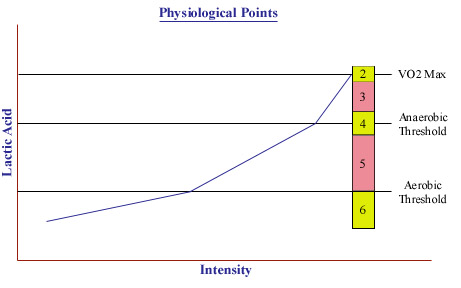| |
TRAINING CATEGORIES
by Chacko Kandathil
An understanding of the main physiological points will help in the determination of the training categories. The graph below represents the three important physiological points and also shows the training categories.

Category VI
- Training intensity is below Aerobic threshold
- Aerobic threshold may be defined as that point when FT fibers are at first recruited
- Targets the ST fibers.
- Normally used in the first part of the preparation period.
- Characterized by long hours on the water at low rates.
- The size and volume of ST fibers play a significant role in the aerobic capacity of the athlete
- Type of work - Continuous steady state
- Heart rate - 130-145
- Blood Lactate - below 2 mMol/L
Category V
- Training intensity is above Aerobic threshold but below anaerobic threshold
- Represents a wide range of training intensities
- Area where the largest volume of training is done
- Recruits primarily ST fibers but also enlists a certain percentage of FOG and FT fibers
- Type of work - Continuous steady state
- Heart rate - 145-160
- Blood Lactate - 2 - 4 mMol/L
Category IV
- Represents a narrow area around the Anaerobic Threshold
- Training at this intensity has a quick effect on improving AT
- Alternating work just below and just above AT is an effective way of training in this category.
- Has the effect of increasing the proportion of FOG (Fast Oxidative Glycolytic) fibers
- Type of work - Continuous or Alternating
- Heart rate - 165-175
- Blood Lactate - 3.5 - 5 mMol/L
Category III
- Represents intensities above the Anaerobic Threshold and below VO2 max
- Most of the cardio-vascular adaptations take place at this intensity
- Effective for quick improvement of VO2 max
- Develops ability to work at high levels of lactate
- Promotes lactate recovery
- Work should be in Intervals
- Normally used during the pre-competitive and competitive phase
- There should not be too many sessions of this category
- Type of work - Intervals
- Heart rate - 180 - 190
- Blood Lactate - 6-10 mMol/L
Category II
- Intensity is at VO2 max
- Objective is to increase VO2 max and endurance at VO2 max
- Gives the feel of race pace
- There should not be too many sessions of this category
- Type of training - Intervals
- Heart rate - above 190
Category I
- Represents work at above race pace
- Used only to a limited extent during competition period
- Sharpens neuro muscular reactions
- Type of work - Short Intervals
|


